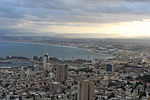Wadi Nisnas

Wadi Nisnas (Arabic: وادي النسناس; Hebrew: ואדי ניסנאס) is a formerly mixed Jewish and Arab neighborhood in the city of Haifa in northern Israel, which is becoming mixed again. Nisnas is the Arabic word for mongoose, an indigenous animal. The wadi has a population of about 8,000 inhabitants.Wadi Nisnas was developed at the end of the nineteenth century as a Christian-Arab neighborhood outside the walls of Haifa, after 1948 the neighborhood become the center of Haifa Arab community, providing the community with education, religious, and other civic and cultural services. The current Israeli Central Bureau of Statistics census estimates that 66% of the Wadi Nisnas population are Christians, 31.5% are Muslims, and the rest are Jews.Wadi Nisnas is the setting for the 1987 novel, Hatsotsrah ba-Vadi (Hebrew: "Trumpet in the Wadi") by Sami Michael. It centers on the love story between a young Israeli Arab woman and a new Jewish immigrant from Russia.
Excerpt from the Wikipedia article Wadi Nisnas (License: CC BY-SA 3.0, Authors, Images).Wadi Nisnas
Khoury, Haifa Wadi Nisnas
Geographical coordinates (GPS) Address Nearby Places Show on map
Geographical coordinates (GPS)
| Latitude | Longitude |
|---|---|
| N 32.816388888889 ° | E 34.996388888889 ° |
Address
ח'ורי/י.ל.פרץ
Khoury
3341231 Haifa, Wadi Nisnas
Haifa District, Israel
Open on Google Maps








